Looking to shift larger quantities, increase your presence in the marketplace and promote customer loyalty amongst your trading partners? A growth rebate programme will help you do it all.
An effective B2B rebate pricing strategy is a great way to drive sales, move large volumes of product and increase profit margins across your product portfolio.
There are many different ways a growth rebate programme can be structured – and the type of rebate you use in your incentive programmes and marketing strategies all depends on the type of desired customer behaviour you’re looking to drive.
In this article, we’ll take a closer look at a variety of growth rebate programmes and consider how each can be used to offer value to your customers as a means to drive commitment, loyalty and ultimately revenue.
Volume Incentive Rebates
Volume rebates are perhaps the most common type of rebate used to drive revenue growth. The incentive offered essentially means that the more your customers purchase from you over the course of the agreement, the better the rebate you offer them.
This helps promote loyalty with your customers – it reduces the risk of buyers consulting competitors about similar products – while also motivating them to buy more.
Volume rebate programmes are usually tiered to encourage growth in orders – and, by natural extension, revenue.
For example, you may structure your volume-based growth rebate programme with the following incentive targets of 100, 500 and 1,000 units:
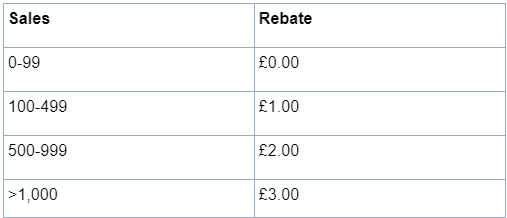
Alternatively, you can offer rebates based on the value of orders (rather than volume) to encourage loyalty and incentivise buyers to spend more. In this case, the rebate is calculated as a percentage.
For example:
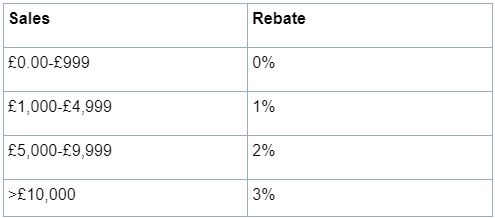
Growth rebates
While volume-based incentives are great for driving growth in the volume or value on individual or short-term orders, there’s still no guarantee that this growth will be sustained over a longer period of time.
This is where a growth rebate can be applied. Based on incremental growth in orders over time, a growth rebate is essentially a variation on a volume rebate, where year-over-year growth is a condition attached to the volume-based (or value-based) agreement.
In this scenario, you will pay rebates to customers when their spend has increased by a certain volume, value or percentage above a predefined baseline.
For example:
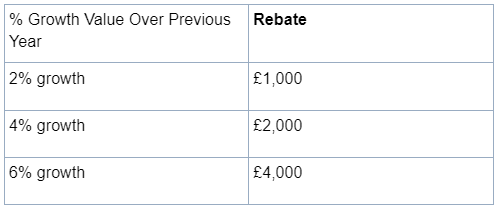
Retention Rebates
This type of rebate is specifically designed to reward customer loyalty or continued, regular business.
Customer retention is important when trying to protect overall margins. The reason is that customer retention drives profitability – studies have shown that it costs an organisation five times more to attract a new customer, than it does to retain an existing one.
Some studies have even found that increasing retention by just 5% can increase profits from 25-95%. Why? Because the success rate of selling to a customer you already have is 60-70%, while the success rate of selling to a new customer is just 5-20%.
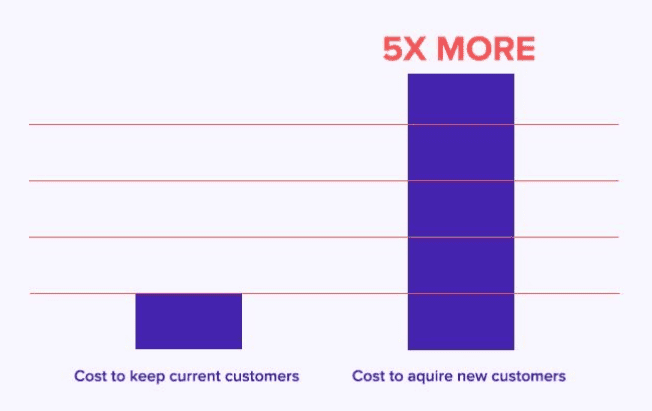
Rebates act as a fantastic reward for customer loyalty. Any type of rebate can be used for driving retention – but the retention rebate in particular is designed specifically to reward continued business.
Retention rebates are accrued over time and typically paid at the end of the year. For example, your customer can earn a rebate for every quarterly, bi-monthly or monthly order – but the rebate is only paid at the end of a twelve-month period if all orders come in. As such, retention rebates provide an incentive for B2B customers to purchase consistently and regularly over time.
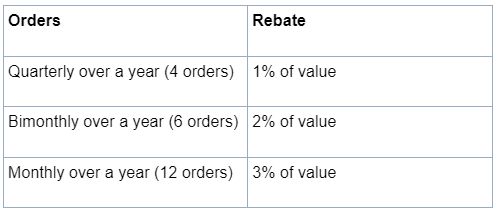
Mix Rebates
Mix rebates – also called product mix rebates – are another fantastic option to help B2B sellers drive revenue growth. They are used to encourage individual buyers, distributors and buying groups to make purchases across a wider range of products than they currently do.
Product mix rebates are especially useful when a customer usually only buys one or two lines from you and you want to entice them away from other suppliers for additional products you sell.
For example, let’s say you’re a wholesaler in the FMCG industry. You have a deal in place with a buying group, which currently only buys cosmetics from you, but sources toiletries elsewhere. The group has a fixed demand for cosmetics – so there’s little you can do to incentivise growth in these lines. However, what you can do is offer the buying group a rebate on the cosmetics if they buy toiletries as well. This way, the buying group gets a better price on their regular order of cosmetics (encouraging loyalty), while you, as the supplier, secure larger orders across a greater range of products.
Mix rebates work quite simply – buyers get a rebate on their existing order of product X on the condition they also buy product Y. Once again, pricing can be tiered to encourage a greater volume or value of purchases.
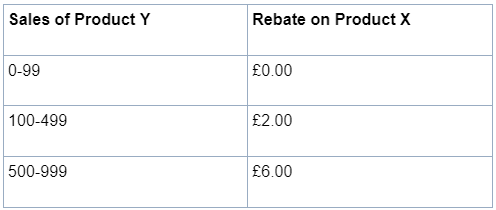
Using Rebate Management Software to Optimise Your Growth Strategy
Building an effective rebate programme is a great way to create a loyal customer base across the supply chain that leads to revenue growth for your company. This is because rebates are great motivators. Customers get more value for money when they make purchases – and the more purchases they make, the better value they receive.
It’s important, however, that you manage your rebate programmes effectively. Having multiple deals in place spanning multiple products and multiple customers is a recipe for complexity. As such, a lack of proper rebate management tools and procedures can reduce a rebate programme’s success.
The solution is to invest in rebate management software, which allow organisations to quickly and easily implement many different types of rebate and personalise them for different customers and buying groups. The best solutions on the market today come with deal modelling features, allowing you to draft new rebate deals in advance and analyse their potential impact before approaching customers with an offer.
When the deal is live, the software then automatically tracks all sales made against your various deals, with calculation engines processing all sales data in real time so you can proactively monitor and evaluate the performance of each of your deals. Using these analyses, you can then determine which type of rebate to employ – and to which customers – in order to drive the most favourable revenue growth and meet your business objectives.
To learn more about how implementing a growth rebate strategy can positively impact your business, talk to our experts at e-bate today for more information or to request a demo of our intelligent rebate management solution.

